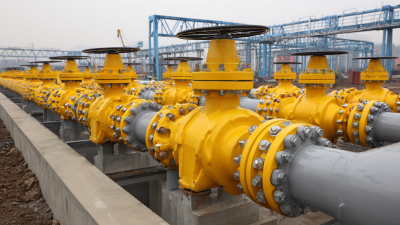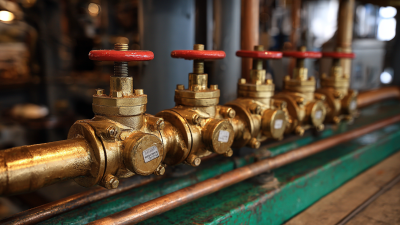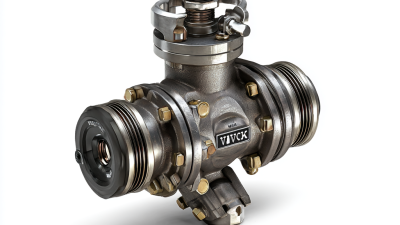The Future of Inline Check Valve Innovations and Their Impact on Industries
The inline check valve is rapidly evolving as a critical component across various industries, including oil and gas, water treatment, and manufacturing.
 According to a report by MarketsandMarkets, the global check valve market is projected to reach USD 9.2 billion by 2025, growing at a CAGR of 5.2% from 2020 to 2025. This growth is driven by increasing demand for efficient fluid management systems and advancements in valve technology, enhancing reliability and performance. Innovations in inline check valve design, such as improved sealing mechanisms and materials, are set to significantly impact operational efficiency and maintenance costs. As industries strive to optimize productivity and reduce downtime, the future of inline check valve technologies presents exciting possibilities that promise to reshape traditional processes and standards.
According to a report by MarketsandMarkets, the global check valve market is projected to reach USD 9.2 billion by 2025, growing at a CAGR of 5.2% from 2020 to 2025. This growth is driven by increasing demand for efficient fluid management systems and advancements in valve technology, enhancing reliability and performance. Innovations in inline check valve design, such as improved sealing mechanisms and materials, are set to significantly impact operational efficiency and maintenance costs. As industries strive to optimize productivity and reduce downtime, the future of inline check valve technologies presents exciting possibilities that promise to reshape traditional processes and standards.
The Rise of Smart Inline Check Valves: A Game Changer in Automation
The rise of smart inline check valves marks a pivotal shift in automation technology across various industries. As AI continues to integrate into our daily lives, the infusion of intelligent systems into check valves enhances operational efficiency and reliability. These smart valves can monitor system performance in real-time, allowing for instantaneous adjustments that prevent issues before they escalate. The result is not only reduced downtime but also significant cost savings in maintenance and operational disruptions.
Tips: When considering the implementation of smart inline check valves, it’s essential to prioritize compatibility with existing systems. Conduct a thorough assessment of your current infrastructure to ensure seamless integration. Additionally, investing in training for your workforce will help leverage the full potential of these advanced technologies, fostering innovation within your team.
As industries evolve, the combination of automation and smart technologies transforms how processes are managed. Inline check valves equipped with AI capabilities can analyze data trends and predict future needs, paving the way for proactive management strategies. This evolution promises to elevate productivity and streamline operations, demonstrating the profound impact of automation on industry standards.

Key Innovations Driving Inline Check Valve Efficiency and Reliability
The inline check valve industry is witnessing a remarkable transformation driven by key innovations that enhance efficiency and reliability. Advanced materials, such as composites and specialized alloys, are being adopted to improve corrosion resistance and extend the lifespan of valves in various applications. These innovations not only minimize maintenance needs but also optimize performance, ensuring systems run smoothly under pressure.
Tip: When selecting an inline check valve, prioritize valves made from materials suited to your specific environment. Understanding the chemical compatibility and temperature considerations can significantly reduce long-term operational issues.
Additionally, smart technology integration is reshaping inline check valves. IoT-enabled check valves equipped with sensors can monitor flow rates, pressure fluctuations, and operational status in real-time. This data-driven approach allows industries to predict failures before they occur, facilitating preventative maintenance and minimizing downtime.
Tip: Consider investing in smart check valve systems if your operation relies heavily on continuous flow processes. The initial investment can lead to substantial savings through increased reliability and reduced emergency repairs.
The Impact of Inline Check Valve Technology on Sustainability Practices
Inline check valves are making significant strides in enhancing sustainability practices across various industries. By preventing backflow and maintaining consistent fluid dynamics, these valves play a crucial role in optimizing resource utilization, particularly in sectors like agriculture and water management. Recent data suggests that the integration of advanced technologies in agriculture, such as robotics and AI, could reduce crop losses by up to 30%, demonstrating the potential for inline check valves to facilitate more efficient water usage and nutrient delivery systems.
Moreover, industries are increasingly recognizing the importance of minimizing their ecological footprint. Inline check valve technology is being innovated to not only improve operational efficiency but also to reduce waste in production processes. Studies indicate that advancements in valve designs can lead to performance improvements, reducing maintenance needs by up to 25%, which directly correlates to lower material consumption and reduced emissions in manufacturing. This aligns with broader efforts to enhance sustainability, as industries aim to address significant challenges, such as product returns that contribute to environmental strain, which account for millions of tons of waste annually.
Integrating IoT with Inline Check Valves for Real-Time Monitoring
The integration of IoT with inline check valves represents a significant breakthrough in industrial automation and efficiency. Real-time monitoring powered by IoT technology allows operators to gather critical data on valve performance, pressure levels, and flow rates. According to a 2022 report by MarketsandMarkets, the IoT in industrial applications is expected to grow at a staggering CAGR of 24.1%, highlighting the urgent need for industries to adopt these innovations. By equipping inline check valves with sensors, companies can facilitate predictive maintenance, reducing downtime and operational costs.
Tip: Ensure that your inline check valves are compatible with IoT sensors to maximize monitoring capabilities. Regularly train your team on the use of these technologies to keep up with evolving trends and enhance efficiency.
The impact of this innovation extends beyond mere efficiency. Real-time data collection can lead to enhanced safety measures as anomalies can be detected and rectified before they escalate into serious issues. For instance, reducing the potential for backflow or leaks not only protects equipment but also safeguards the environment. A recent study indicated that integrating IoT solutions in fluid dynamics could lower maintenance costs by up to 30%.
Tip: Consider implementing a pilot program for IoT-enabled inline check valves to evaluate their benefits before a full-scale rollout. This approach can help identify specific areas where improvements can be made and assist in strategic planning.
The Future of Inline Check Valve Innovations and Their Impact on Industries
| Industry |
Current Check Valve Use |
IoT Integration |
Benefits |
Future Trends |
| Oil & Gas |
Safety and flow control |
Real-time pressure and flow monitoring |
Reduced leaks, improved safety |
Smart valves with predictive analytics |
| Water Treatment |
Flow regulation, backflow prevention |
Data collection on water quality |
Enhanced efficiency, compliance tracking |
Automated systems for water quality management |
| Food & Beverage |
Preservation of product quality |
Monitoring of temperature and flow |
Improved safety standards, waste reduction |
Traceability from production to consumption |
| Manufacturing |
Control of liquids and gases |
Automation and smart integrations |
Increased uptime, operational efficiency |
Integration with Industry 4.0 technologies |
Future Trends in Inline Check Valve Design: What to Expect in the Next Decade
The next decade promises to usher in remarkable advancements in the design of inline check valves, driven by the need for
greater efficiency, reliability, and environmental sustainability
across various industries. Innovative materials and technologies are expected to play a crucial role in the evolution of these essential components.
For instance, the integration of
smart technology
could allow for real-time monitoring and predictive maintenance, significantly reducing downtime and operational costs.
Additionally, the push for eco-friendly solutions may lead to the development of check valves that
minimize leakage and energy consumption, aligning with global efforts towards sustainability.

Another trend on the horizon is the customization of inline check valves to meet specific application requirements.
Industries such as oil and gas, food and beverage, and pharmaceuticals
are increasingly demanding specialized solutions that enhance performance and compliance with stringent regulations.
Manufacturers are likely to focus on
modular designs that allow for easy adaptation and upgrades, facilitating faster response times to market changes.
As these innovations unfold, stakeholders can expect a more interconnected and efficient industrial ecosystem,
where inline check valves contribute significantly to both performance and environmental goals.
 © Copyright 2020 Tianjin Tanghaidongyang Valve Co., Ltd. All Rights Reserved.
© Copyright 2020 Tianjin Tanghaidongyang Valve Co., Ltd. All Rights Reserved.
 According to a report by MarketsandMarkets, the global check valve market is projected to reach
According to a report by MarketsandMarkets, the global check valve market is projected to reach 








